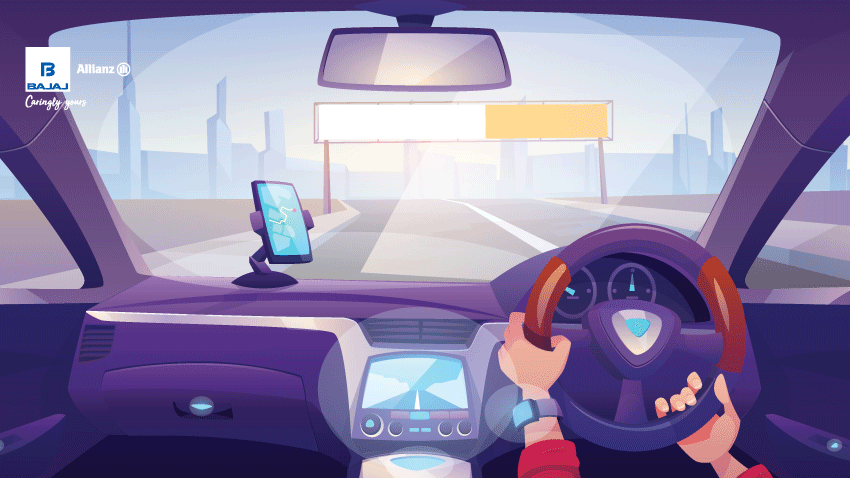With the rapid advancements in automotive technology, car modifications aimed at enhancing personalisation and performance are becoming more popular. One such innovation is the Heads-Up Display (HUD). Once reserved for high-end luxury cars, HUD technology is now becoming more accessible in various car models and brands in India.
In this blog, we will explore what a heads-up display is, how it works, and its benefits. Additionally, we'll discuss the importance of having adequate car insurance online to cover such advanced features.
What is a Heads-Up Display?
A Heads-Up Display (HUD) is a technology that projects important driving information directly onto the windshield or a transparent screen in the driver's line of sight. This allows drivers to see critical data like speed, navigation directions, and safety alerts without having to take their eyes off the road.
Initially, HUD technology was primarily used in fighter jets to provide pilots with essential information. However, it has since been adapted for automotive use, significantly improving the driving experience and enhancing safety.
How Does a Heads-Up Display Work?
A HUD in a car consists of three main components: a light source, a magnifying system, and a reflector. Here’s how these components work together to provide real-time information to the driver:
Information Source:
The information displayed on a HUD comes from the car's computer system, GPS, or other connected devices. This includes data like speed, fuel level, navigation, and safety alerts.
Processing Unit:
Once the information is collected, it is processed and formatted by a processing unit. This ensures the data is displayed in a clear and readable format.
Projection:
The formatted information is then projected onto the windshield or a combiner plate using a projector unit.
Reflection:
The reflector or combiner plate ensures the information is displayed in the driver’s line of sight. This optical combination makes it easy for the driver to see the information without looking away from the road.
Types of Heads-Up Displays
There are two primary types of HUD in cars:
Windscreen Display HUD
The windscreen displays HUD projects information directly onto the car’s windshield. This type of HUD uses a combination of mirrors and prisms to create a virtual image that appears in front of the driver. Heads-up display cars in India are becoming more common in modern cars nowadays.
Combiner-Projected Display HUD
In this type, a transparent screen, known as a combiner plate, is used to reflect the information. The data is projected onto the combiner plate, which is positioned in front of the driver’s sight. This type of HUD is often found in cars that do not have windscreen display technology.
Information Displayed on a HUD
A HUD in a car can display various types of information, including:
Speed:
Current speed is displayed, allowing the driver to keep track without looking down at the speedometer.
Navigation:
Turn-by-turn directions and maps help the driver reach their destination safely.
Fuel Level:
Information on the remaining fuel to avoid sudden stops.
Safety Alerts:
Warnings about potential hazards, such as collisions or lane departures.
Engine Temperature:
Keeps track of the engine's status to prevent overheating.
Cruise Control Status:
Displays the status of cruise control settings.
Headlight Updates:
Alerts about headlight status, especially useful in low visibility conditions.
Benefits of HUDs in Cars
Here are some key benefits of HUDs in cars:
Improved Safety:
By displaying essential information in the driver's line of sight, HUDs help reduce distractions and keep the driver focused on the road. This significantly enhances driving safety.
Enhanced Convenience:
HUDs provide all necessary driving information in one place, reducing the need to look around the car's dashboard. This convenience can lead to a more comfortable driving experience.
Reduced Eye Strain:
Constantly shifting focus between the road and the dashboard can cause eye strain. HUDs minimise this by presenting information directly in the driver’s view.
Customisation:
Some HUD systems allow drivers to customise the displayed information, tailoring it to their specific needs and preferences.
*Vehicle specifications, features, and pricing may vary, and it is essential for readers to verify the latest information from authorised dealerships, manufacturers, or reliable sources before making any purchasing decisions.
Importance of Car Insurance
With the integration of advanced technologies like HUDs, cars are becoming more sophisticated and, consequently, more expensive to repair. This makes having comprehensive car insurance even more crucial. Here’s why:
Coverage for Advanced Features:
Comprehensive car insurance can cover the repair or replacement costs of advanced features like HUDs, which can be quite expensive.
Protection Against Accidents:
Accidents can cause significant damage to your car’s HUD system. Having adequate insurance ensures you’re financially protected against such incidents.
Peace of Mind:
Knowing that your car, with all its advanced features, is adequately insured gives you peace of mind while driving.
The Heads-Up Display is a remarkable innovation in the automotive industry, enhancing both safety and convenience for drivers. By providing real-time information in the driver’s line of sight, HUDs allow for a more focused and enjoyable driving experience.
As these technologies become more widespread in cars across India, it's essential to ensure your vehicle is adequately protected. Opting for comprehensive
car insurance online can safeguard you against the high costs associated with repairing or replacing advanced features like HUDs. So, if you’re in the market for a new car, consider one with a HUD and ensure you have the right insurance coverage to match.
*Standard T&C Apply
*Insurance is the subject matter of solicitation. For more details on benefits, exclusions, limitations, terms, and conditions, please read the sales brochure/policy wording carefully before concluding a sale.
The content on this page is generic and shared only for informational and explanatory purposes. It is based on several secondary sources on the internet and is subject to changes. Please consult an expert before making any related decisions.
 Service Chat: +91 75072 45858
Service Chat: +91 75072 45858


